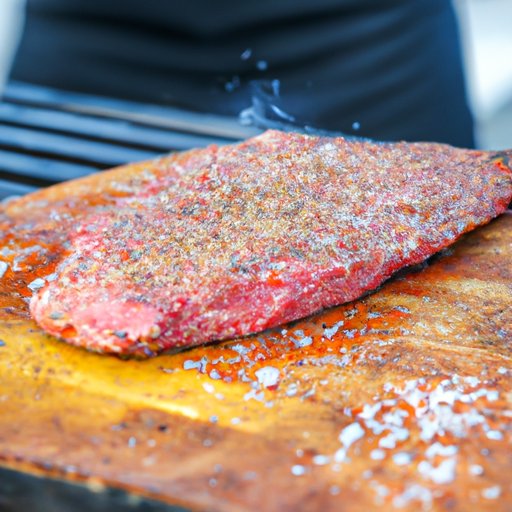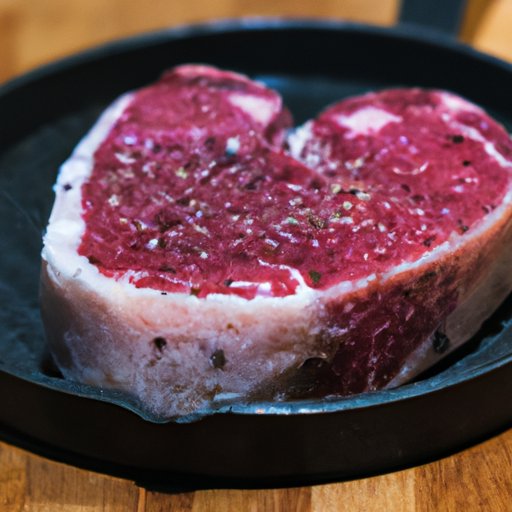
I. Introduction
Have you ever tried marinating a steak but ended up with a lackluster flavor? Marinating a steak requires careful consideration of several factors to achieve that juicy, tender taste.
This ultimate guide on how to marinate a steak covers everything from selecting the right cut of steak to mastering the international techniques of marination. Whether you are a beginner or an experienced home cook, this guide will give you the tools and knowledge needed to elevate your steak dishes.
Marinating a steak not only adds flavor but also tenderizes it, making it easier to chew and digest. Moreover, marination is a healthy technique that lessens the need for using unhealthy sauces that are usually high in sugar or salt.
II. 7 Simple Steps for a Perfect Steak Marinade
A. Selecting the right cut of steak
The first step to a perfect steak is choosing the right cut. The most favored are rib-eye, sirloin, and T-bone steak. These are fine-grained, tender meats that work perfectly for marination.
It’s important to take note of the fat content of the cut. A steak with little fat must either be quick-cooked or shouldn’t be cooked at all, whereas fatty cuts can handle longer cooking periods. Opting for a prime cut of meat is always best, but the cost can add up. When searching for a cut, keep an eye out for marbled steaks or cuts that have been treated with self-basting.
B. Preparing the steak for marination
The ideal way to prepare steak for marination involves scoring the surface diagonally, creating diamond-shaped cuts that help the flavors absorb into the meat. Next, season the steak with salt and pepper, and coat it with the marinade in an airtight container. Make sure to perform this step the night before cooking so, the marinade has enough time to do its thing.
C. Creating a marinade that matches the cut of meat
Marinades are a mixture of oil, acidic elements, seasonings, and herbs. To craft the ideal marinade for your steak, first, decide on a flavor profile, such as a Mexican or Italian marinade.
Matching the right marinade to your steak cut is essential; cuts of meat that are leaner should have more acidic marinades, while fattier cuts lean towards savory, salt-based marinades. A rule of thumb is to use around one cup of marinade per pound of steak, depending on the desired meat flavor.
D. Marinade time and temperature
The length of time the steak should marinate will depend on the cut of the meat and the marinade used. Thin cuts need less marinating. Acidic marinades, such as vinegar-based marinades, need shorter marinating times.
The temperature is also important. Meat must be marinated in the fridge, not outside, to prevent bacterial growth. For meat that has a marinating time of 24 hours or less, you can keep it in the fridge. For a longer period, it’s best to freeze it.
E. Pat your steak dry before cooking
It’s important to remove the marinade before cooking steak. This prevents the outside of the steak from burning, which can result in a bitter taste. Use paper towels to pat the steak dry and then cook it according to your preferred method.
F. Tips for cooking your steak
A great way to cook steak is by searing it in a greased, non-stick pan over medium-high heat for about two minutes on each side. This can produce a rare or medium-rare steak. Additionally, grilling steak can produce a great smoky flavor. Gradually grill the steak until it reaches the desired temperature and then remove it right away to rest for roughly ten minutes. This allows it to finish cooking evenly and lets the juices reabsorb into the meat. Tent the steak with a sheet of foil to keep it warm before serving.
III. Marinating Magic: Elevate Your Steak’s Flavor
A. Key marinade ingredients
Take your marinade to the next level by adding a couple of specific ingredients.
- Acidity: Use acidic components like vinegar, lemon juice, and soy sauce to help tenderize the meat.
- Oil: Using the right oil can complement the flavor of the steak well. Olive oil is a standard option, but sesame or peanut oil can add depth to the flavor.
- Herbs and Spices: Consider ingredients such as chili, ginger, garlic, rosemary, or thyme to add a punch of flavor.
B. The effects of acids, enzymes, and fats on steak
A high acidic marinade can weaken muscle fibers and make the meat tender. The enzymes in the marinade can also work to break down the protein in meat, making it more delicate. Fats added to the marinade, such as olive oil, can deliver extra flavor to the steak when it is cooked.
C. Tips for creating a balanced flavor profile
Don’t be afraid of experimenting with bold flavor combinations in your marinade; however, it’s necessary to balance the favors. Doing this can make the difference between a zesty steak and an overpowering one. For example, if you’re using lemons or limes, avoid adding more acidic ingredients like vinegar as this can lead to too much acidity. Mixing herbs like rosemary or thyme with garlic can make a great savory marinade.
IV. The Science Behind Steak Marination: Tips and Tricks
A. The science of meat
The science of marinating meat gets somewhat complicated. Marination can generally be viewed in two parts: the chemical breakdown of muscle fibers with acid or enzymes and the absorption or infusion of marinade flavors by the meat. When meat is marinated, the marinade’s acids break down its cell structure, increasing the moisture retention and allowing it to absorb flavors better.
B. Tips on how each ingredient affects your steak
Every ingredient in your marinade impacts the flavor and texture of your steak. For example, soy sauce is known for tenderizing meat, but it also gives a marinade its robust flavor. Adding sugar or honey to the marinade can help balance out any sour flavors from acid.
C. Different uses for marinades
Marinades are not just limited to beef steak, they can marinate poultry, fish, and pork too! Turkey, chicken, and seafood usually don’t require a long cook time before consuming, so marinating them for a few hours is sufficient. When preparing different meats, be sure to adjust the marinade’s ingredients as necessary.
V. Getting Creative with Steak Marinades: Unconventional Flavors to Try
A. Discussion of lesser-known marinade ingredients
Exploring specific ingredients that aren’t usually associated with steak marinades can result in surprisingly pleasant tastes. Lesser-known marinade ingredients such as Greek yogurt or red wine vinegar can craft a different yet functional marination.
B. Examples of marinade combinations that are unique and bold
Try ginger, soy sauce, orange juice, and honey marinade for an Asian-inspired dinner or a red wine, garlic, and rosemary marinade for an Italian touch. Maintain a careful balance of flavors, and you might end up with a new favorite flavor combination.
C. Tips for experimenting with unconventional flavors
To find the best unconventional flavor, it’s essential to start small with the quantities of each ingredient, experimenting cautiously. A great tip is to prepare smaller cuts of meat, primarily if you have never tried the recipe before, which will prevent wasting meat or ingredients.

VI. Marination 101: The Basics of Preparing a Tasty Steak
A. Brief overview of the technicalities of marinating
Marination might appear a little overwhelming if you’re a beginner. However, the basics are relatively straightforward. Pick the correct cut of meat, prepare it well, select the appropriate ingredients, and soak it long enough.
B. Rules of marination for a beginner
For a novice cook, marinating beef requires special attention to the marinade recipe to achieve a flavorful steak.
- Use a glass, stainless steel, or plastic container to prevent metallic interaction.
- Avoid using salt in your marinade to reduce bacterial growth and discoloration of the meat.
- Save a small batch of the marinade to brush the steak while it cooks.
C. Tips that make the process of marination significantly easier
Time can be preserved by pre-preparing marinade and freezing it. Make multiple batches of marinades and store them in freezer-safe bags. This will speed up the process of producing the perfect marination.
VII. A Taste of Summer: Grilling Tips and Tricks with Steak Marinades
A. Best grilling methods for steak
Grilling steak is one of the best ways to cook it. Applying oil, salt, and pepper to the steak produces an excellent natural crust on the steak during grilling. It is ultimately up to you whether to grill steak using charcoal, gas, or electric grilling, depending on the situation or the flavor you’re wanting to create.
B. Tips for achieving perfect grill marks
Many avid grillers aim for those aesthetically pleasing grill marks on their steaks, that appear when the meat touches the grill. You can achieve perfect grill marks by placing your steak at a forty-five-degree angle on the grill. After the grill marks have been created, turn the steak over and cook the other side.
C. Preparation and storage of your marinade
Marinades can stay fresh for up to a week in the fridge, making it easy to prepare ingredients and store them the night before cooking. Be sure to store raw meat and marinade separately to prevent bacterial contact, and refrigerate both at 40°F or lower.
VIII. From Korean to Caribbean: Global Steak Marination Techniques You Need to Know
A. Widely used global marinade techniques
Global marination includes incorporating popular and unique marination styles worldwide. These styles vary widely across different countries and regions, depending on individual taste and preference. Popular styles include Caribbean Jamaican, Korean and Argentinian.
B. Exploring a variety of international flavors
Marinades can give the steak a delicious twist from the various global flavors available. For instance, Korean barbecue steak has a savory marinade, including soy sauce, sesame seeds, and honey, which add sweetness and robust flavor to the meat.
C. Tips for mastering global techniques at home
Research and experimentation can help individuals master global marination methods. The internet can provide a wealth of information on different techniques and ingredients. Creating small batches of marinade from different cultures allows for better taste testing and combining flavors between unique techniques and tastes.
IX. Conclusion
This ultimate guide to marinating a steak has played a significant role in providing a wide range of techniques for marinating and grilling steak. From the science behind marinating techniques to international flavors and unconventional marinade ingredients, this guide has something for everyone.
As a final tip, remember that patience is key, and your efforts won’t go unnoticed when you serve that perfectly marinated steak. Always aim to vary the flavors and experiment within your kitchen with different ingredients, and you might end up with a new favorite steak dish.




